Economics Assignment: Elasticity, Consumer Choice, and Revenue
VerifiedAdded on 2023/05/30
|7
|1048
|199
Homework Assignment
AI Summary
This economics assignment addresses key microeconomic concepts, including the distinction between the short run and long run, and the concept of elasticity of demand. It analyzes the price elasticity of gasoline, demonstrating how demand responsiveness differs over time. The assignment also explores consumer choice theory, using indifference curves and budget constraints to determine optimal bundles. Furthermore, it examines how changes in price affect consumer behavior and seller revenue. The student's work provides detailed answers to questions regarding elasticity calculations, the effects of price changes, and the application of these concepts to real-world scenarios. The assignment concludes with an analysis of irrational behavior related to sunk costs.
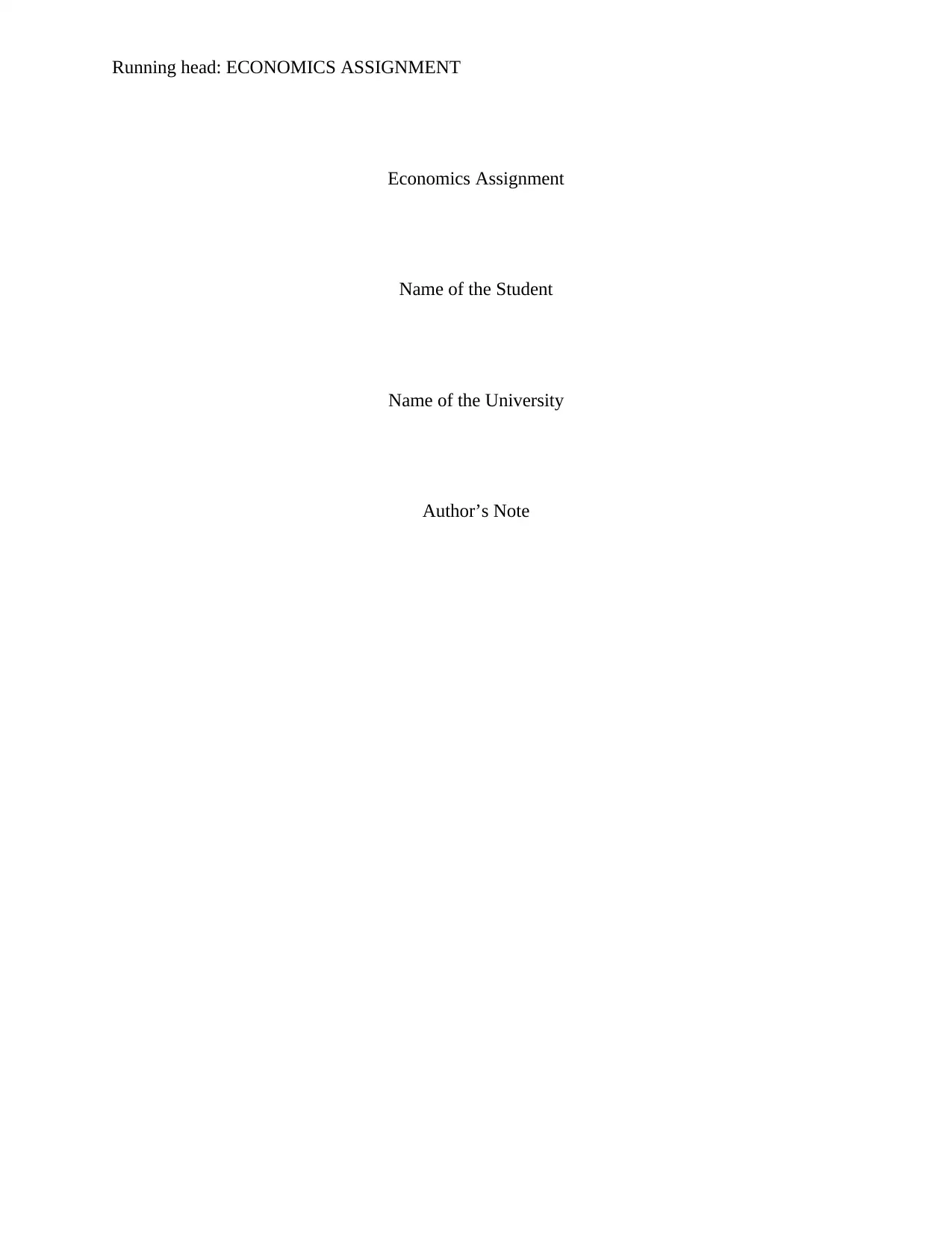
Running head: ECONOMICS ASSIGNMENT
Economics Assignment
Name of the Student
Name of the University
Author’s Note
Economics Assignment
Name of the Student
Name of the University
Author’s Note
Paraphrase This Document
Need a fresh take? Get an instant paraphrase of this document with our AI Paraphraser
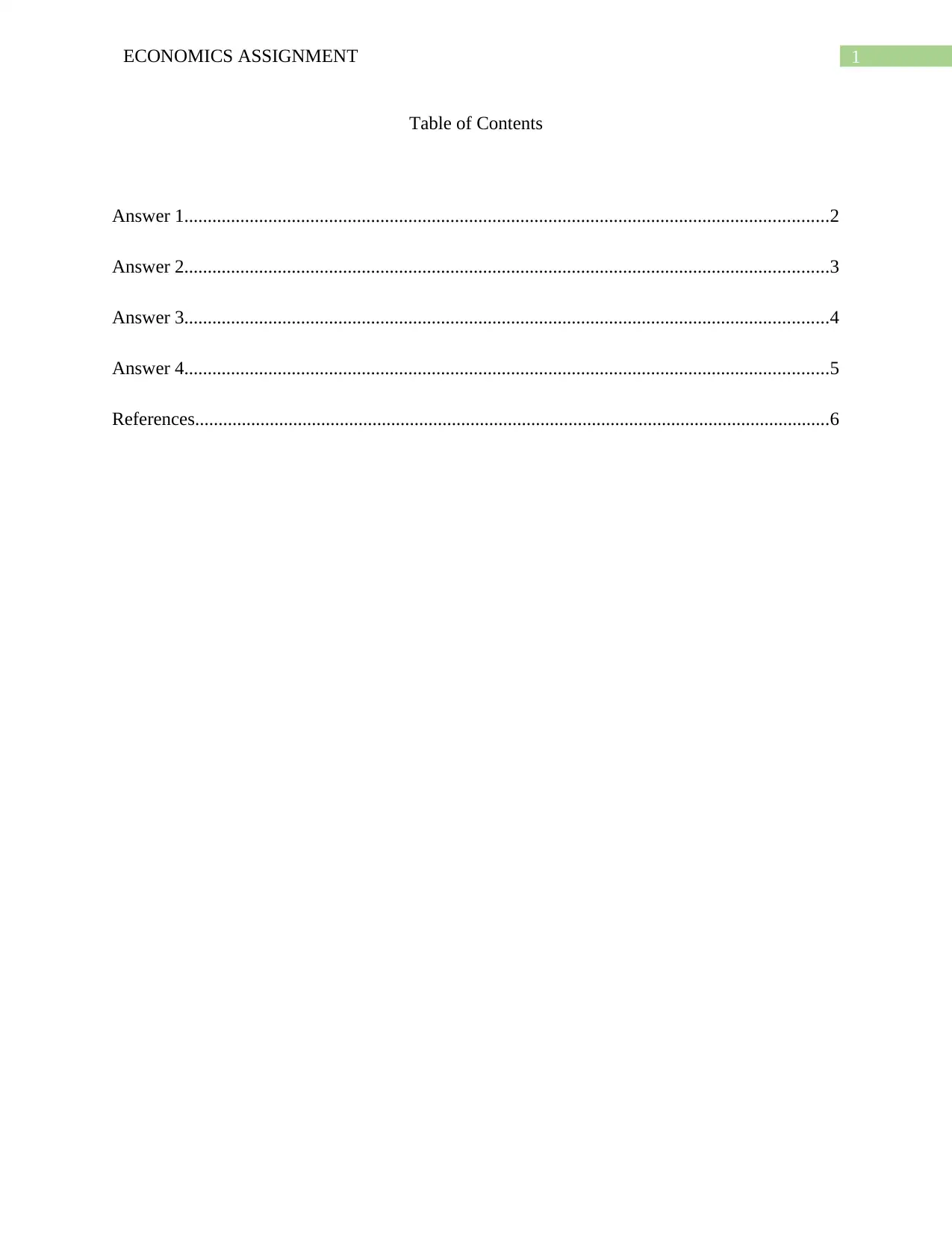
1ECONOMICS ASSIGNMENT
Table of Contents
Answer 1..........................................................................................................................................2
Answer 2..........................................................................................................................................3
Answer 3..........................................................................................................................................4
Answer 4..........................................................................................................................................5
References........................................................................................................................................6
Table of Contents
Answer 1..........................................................................................................................................2
Answer 2..........................................................................................................................................3
Answer 3..........................................................................................................................................4
Answer 4..........................................................................................................................................5
References........................................................................................................................................6
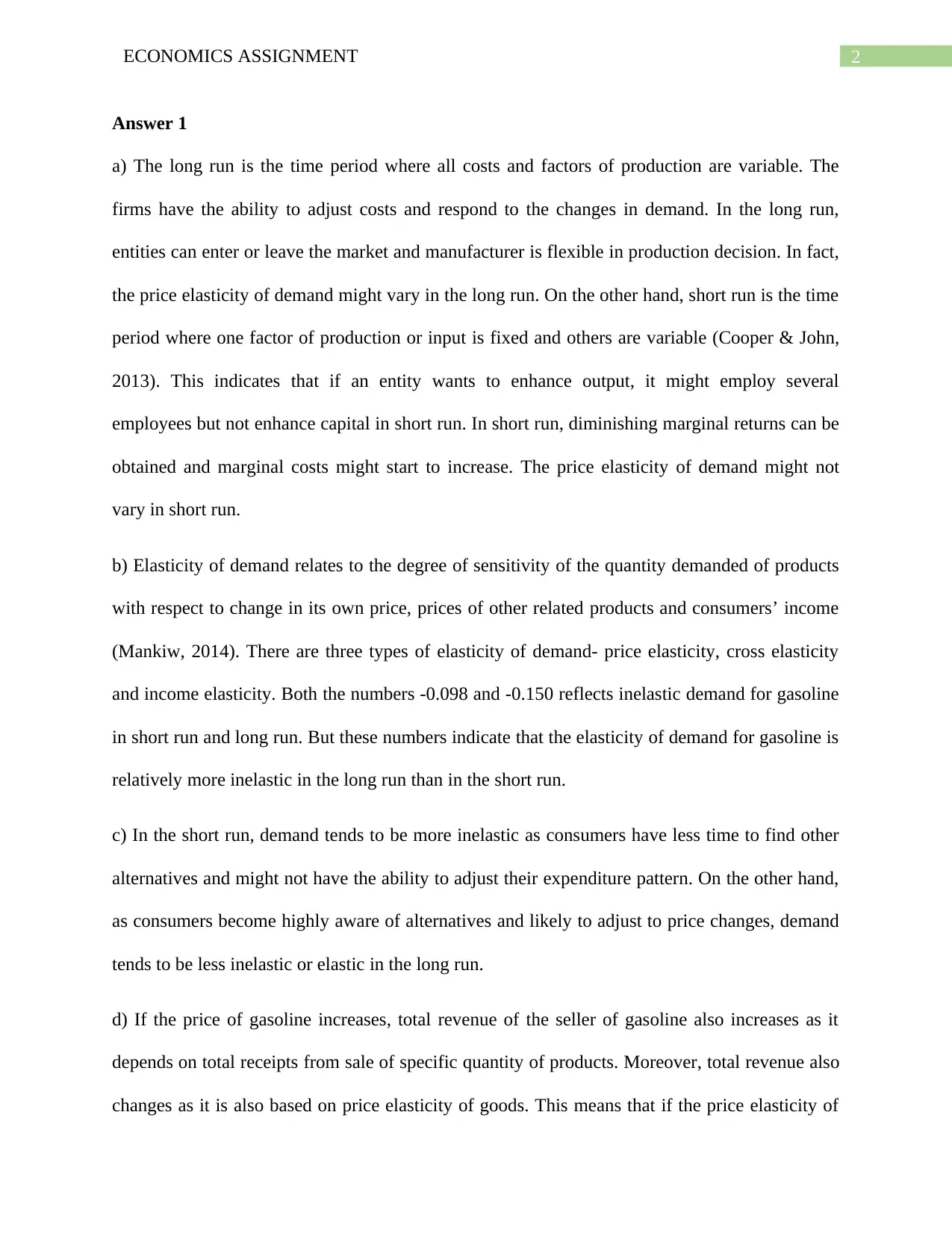
2ECONOMICS ASSIGNMENT
Answer 1
a) The long run is the time period where all costs and factors of production are variable. The
firms have the ability to adjust costs and respond to the changes in demand. In the long run,
entities can enter or leave the market and manufacturer is flexible in production decision. In fact,
the price elasticity of demand might vary in the long run. On the other hand, short run is the time
period where one factor of production or input is fixed and others are variable (Cooper & John,
2013). This indicates that if an entity wants to enhance output, it might employ several
employees but not enhance capital in short run. In short run, diminishing marginal returns can be
obtained and marginal costs might start to increase. The price elasticity of demand might not
vary in short run.
b) Elasticity of demand relates to the degree of sensitivity of the quantity demanded of products
with respect to change in its own price, prices of other related products and consumers’ income
(Mankiw, 2014). There are three types of elasticity of demand- price elasticity, cross elasticity
and income elasticity. Both the numbers -0.098 and -0.150 reflects inelastic demand for gasoline
in short run and long run. But these numbers indicate that the elasticity of demand for gasoline is
relatively more inelastic in the long run than in the short run.
c) In the short run, demand tends to be more inelastic as consumers have less time to find other
alternatives and might not have the ability to adjust their expenditure pattern. On the other hand,
as consumers become highly aware of alternatives and likely to adjust to price changes, demand
tends to be less inelastic or elastic in the long run.
d) If the price of gasoline increases, total revenue of the seller of gasoline also increases as it
depends on total receipts from sale of specific quantity of products. Moreover, total revenue also
changes as it is also based on price elasticity of goods. This means that if the price elasticity of
Answer 1
a) The long run is the time period where all costs and factors of production are variable. The
firms have the ability to adjust costs and respond to the changes in demand. In the long run,
entities can enter or leave the market and manufacturer is flexible in production decision. In fact,
the price elasticity of demand might vary in the long run. On the other hand, short run is the time
period where one factor of production or input is fixed and others are variable (Cooper & John,
2013). This indicates that if an entity wants to enhance output, it might employ several
employees but not enhance capital in short run. In short run, diminishing marginal returns can be
obtained and marginal costs might start to increase. The price elasticity of demand might not
vary in short run.
b) Elasticity of demand relates to the degree of sensitivity of the quantity demanded of products
with respect to change in its own price, prices of other related products and consumers’ income
(Mankiw, 2014). There are three types of elasticity of demand- price elasticity, cross elasticity
and income elasticity. Both the numbers -0.098 and -0.150 reflects inelastic demand for gasoline
in short run and long run. But these numbers indicate that the elasticity of demand for gasoline is
relatively more inelastic in the long run than in the short run.
c) In the short run, demand tends to be more inelastic as consumers have less time to find other
alternatives and might not have the ability to adjust their expenditure pattern. On the other hand,
as consumers become highly aware of alternatives and likely to adjust to price changes, demand
tends to be less inelastic or elastic in the long run.
d) If the price of gasoline increases, total revenue of the seller of gasoline also increases as it
depends on total receipts from sale of specific quantity of products. Moreover, total revenue also
changes as it is also based on price elasticity of goods. This means that if the price elasticity of
⊘ This is a preview!⊘
Do you want full access?
Subscribe today to unlock all pages.

Trusted by 1+ million students worldwide
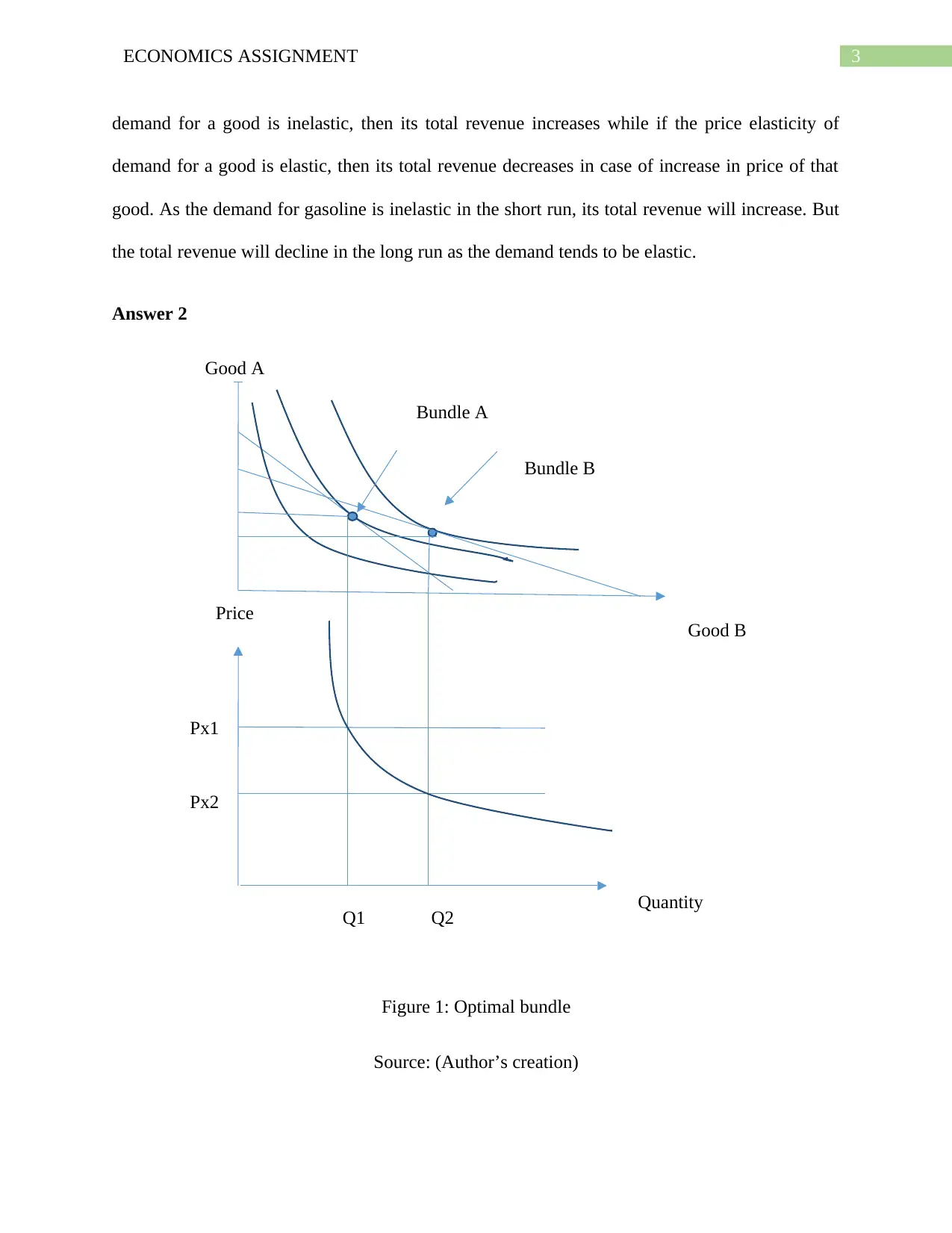
3ECONOMICS ASSIGNMENT
Bundle A
Bundle B
Good B
Good A
Price
Quantity
Px1
Px2
Q1 Q2
demand for a good is inelastic, then its total revenue increases while if the price elasticity of
demand for a good is elastic, then its total revenue decreases in case of increase in price of that
good. As the demand for gasoline is inelastic in the short run, its total revenue will increase. But
the total revenue will decline in the long run as the demand tends to be elastic.
Answer 2
Figure 1: Optimal bundle
Source: (Author’s creation)
Bundle A
Bundle B
Good B
Good A
Price
Quantity
Px1
Px2
Q1 Q2
demand for a good is inelastic, then its total revenue increases while if the price elasticity of
demand for a good is elastic, then its total revenue decreases in case of increase in price of that
good. As the demand for gasoline is inelastic in the short run, its total revenue will increase. But
the total revenue will decline in the long run as the demand tends to be elastic.
Answer 2
Figure 1: Optimal bundle
Source: (Author’s creation)
Paraphrase This Document
Need a fresh take? Get an instant paraphrase of this document with our AI Paraphraser
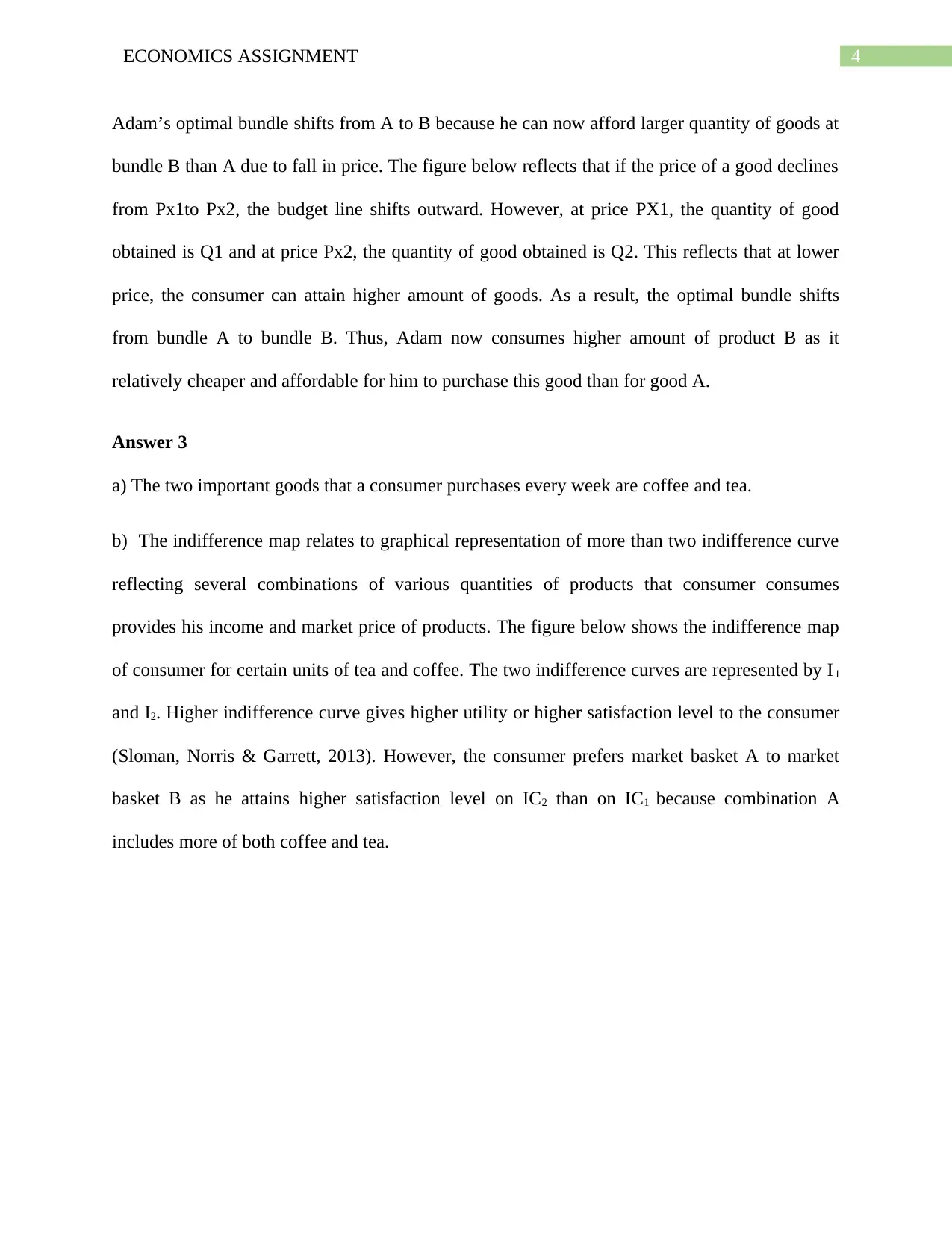
4ECONOMICS ASSIGNMENT
Adam’s optimal bundle shifts from A to B because he can now afford larger quantity of goods at
bundle B than A due to fall in price. The figure below reflects that if the price of a good declines
from Px1to Px2, the budget line shifts outward. However, at price PX1, the quantity of good
obtained is Q1 and at price Px2, the quantity of good obtained is Q2. This reflects that at lower
price, the consumer can attain higher amount of goods. As a result, the optimal bundle shifts
from bundle A to bundle B. Thus, Adam now consumes higher amount of product B as it
relatively cheaper and affordable for him to purchase this good than for good A.
Answer 3
a) The two important goods that a consumer purchases every week are coffee and tea.
b) The indifference map relates to graphical representation of more than two indifference curve
reflecting several combinations of various quantities of products that consumer consumes
provides his income and market price of products. The figure below shows the indifference map
of consumer for certain units of tea and coffee. The two indifference curves are represented by I1
and I2. Higher indifference curve gives higher utility or higher satisfaction level to the consumer
(Sloman, Norris & Garrett, 2013). However, the consumer prefers market basket A to market
basket B as he attains higher satisfaction level on IC2 than on IC1 because combination A
includes more of both coffee and tea.
Adam’s optimal bundle shifts from A to B because he can now afford larger quantity of goods at
bundle B than A due to fall in price. The figure below reflects that if the price of a good declines
from Px1to Px2, the budget line shifts outward. However, at price PX1, the quantity of good
obtained is Q1 and at price Px2, the quantity of good obtained is Q2. This reflects that at lower
price, the consumer can attain higher amount of goods. As a result, the optimal bundle shifts
from bundle A to bundle B. Thus, Adam now consumes higher amount of product B as it
relatively cheaper and affordable for him to purchase this good than for good A.
Answer 3
a) The two important goods that a consumer purchases every week are coffee and tea.
b) The indifference map relates to graphical representation of more than two indifference curve
reflecting several combinations of various quantities of products that consumer consumes
provides his income and market price of products. The figure below shows the indifference map
of consumer for certain units of tea and coffee. The two indifference curves are represented by I1
and I2. Higher indifference curve gives higher utility or higher satisfaction level to the consumer
(Sloman, Norris & Garrett, 2013). However, the consumer prefers market basket A to market
basket B as he attains higher satisfaction level on IC2 than on IC1 because combination A
includes more of both coffee and tea.
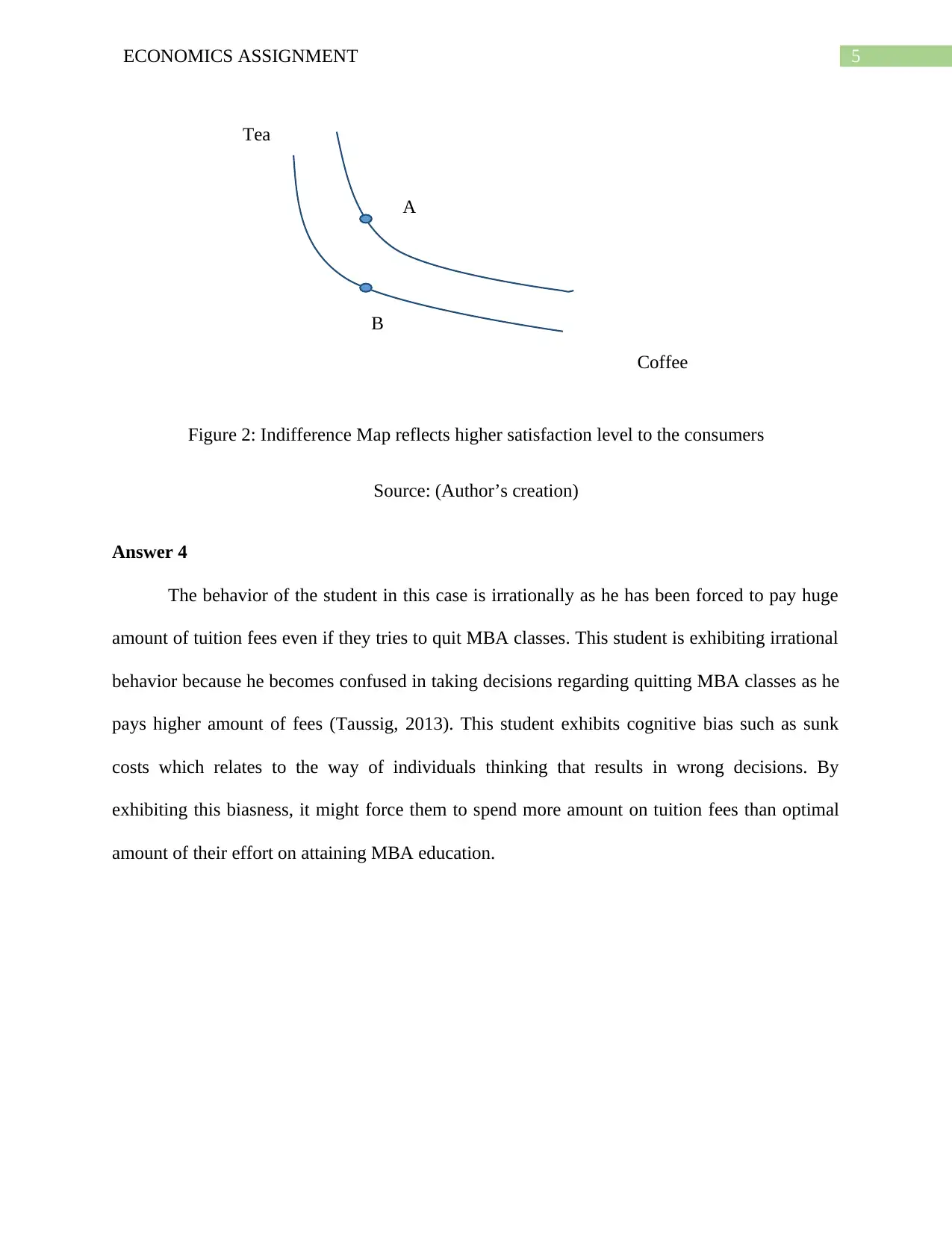
5ECONOMICS ASSIGNMENT
A
B
Coffee
Tea
Figure 2: Indifference Map reflects higher satisfaction level to the consumers
Source: (Author’s creation)
Answer 4
The behavior of the student in this case is irrationally as he has been forced to pay huge
amount of tuition fees even if they tries to quit MBA classes. This student is exhibiting irrational
behavior because he becomes confused in taking decisions regarding quitting MBA classes as he
pays higher amount of fees (Taussig, 2013). This student exhibits cognitive bias such as sunk
costs which relates to the way of individuals thinking that results in wrong decisions. By
exhibiting this biasness, it might force them to spend more amount on tuition fees than optimal
amount of their effort on attaining MBA education.
A
B
Coffee
Tea
Figure 2: Indifference Map reflects higher satisfaction level to the consumers
Source: (Author’s creation)
Answer 4
The behavior of the student in this case is irrationally as he has been forced to pay huge
amount of tuition fees even if they tries to quit MBA classes. This student is exhibiting irrational
behavior because he becomes confused in taking decisions regarding quitting MBA classes as he
pays higher amount of fees (Taussig, 2013). This student exhibits cognitive bias such as sunk
costs which relates to the way of individuals thinking that results in wrong decisions. By
exhibiting this biasness, it might force them to spend more amount on tuition fees than optimal
amount of their effort on attaining MBA education.
⊘ This is a preview!⊘
Do you want full access?
Subscribe today to unlock all pages.

Trusted by 1+ million students worldwide
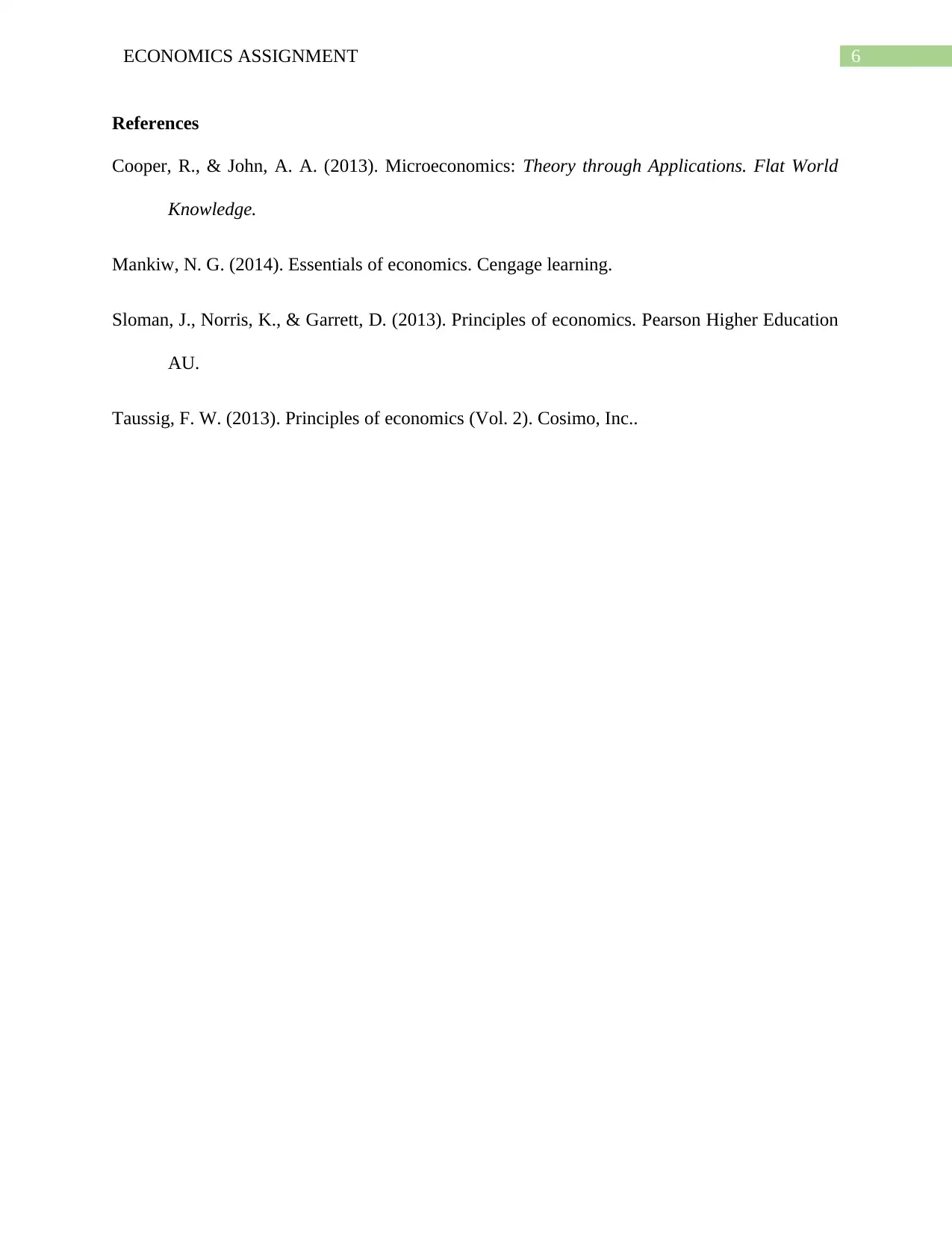
6ECONOMICS ASSIGNMENT
References
Cooper, R., & John, A. A. (2013). Microeconomics: Theory through Applications. Flat World
Knowledge.
Mankiw, N. G. (2014). Essentials of economics. Cengage learning.
Sloman, J., Norris, K., & Garrett, D. (2013). Principles of economics. Pearson Higher Education
AU.
Taussig, F. W. (2013). Principles of economics (Vol. 2). Cosimo, Inc..
References
Cooper, R., & John, A. A. (2013). Microeconomics: Theory through Applications. Flat World
Knowledge.
Mankiw, N. G. (2014). Essentials of economics. Cengage learning.
Sloman, J., Norris, K., & Garrett, D. (2013). Principles of economics. Pearson Higher Education
AU.
Taussig, F. W. (2013). Principles of economics (Vol. 2). Cosimo, Inc..
1 out of 7
Related Documents
Your All-in-One AI-Powered Toolkit for Academic Success.
+13062052269
info@desklib.com
Available 24*7 on WhatsApp / Email
![[object Object]](/_next/static/media/star-bottom.7253800d.svg)
Unlock your academic potential
Copyright © 2020–2025 A2Z Services. All Rights Reserved. Developed and managed by ZUCOL.





